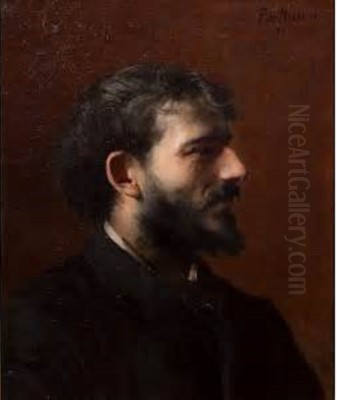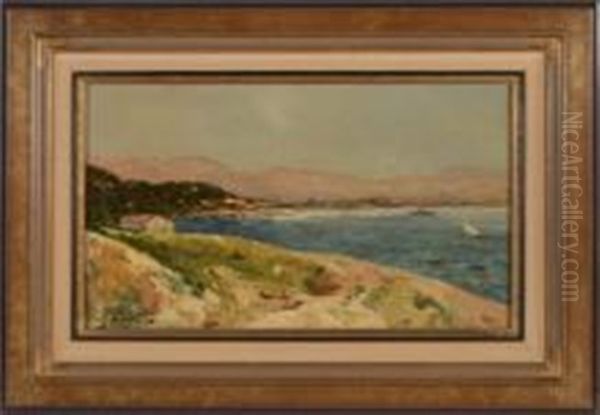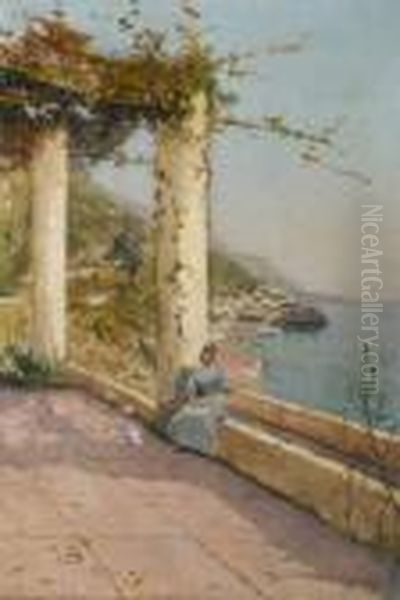
Alfred Casile stands as a fascinating figure within the landscape of French Impressionism. Born in the vibrant southern port city of Marseille in 1848, his artistic journey led him through the rigors of Naturalism and into the heart of the Impressionist revolution, yet he always retained a unique sensibility shaped by diverse influences. His life, spanning until 1909, saw him navigate the artistic currents of his time, developing a style known for its delicate atmospheric effects and subtle handling of light, often distinct from both his Parisian contemporaries and fellow Provençal painters.
From Marseille to Parisian Circles
Alfred Casile's artistic path began in his native Marseille. His initial training grounded him in the principles of Naturalism, particularly under the guidance of Antoine Guillemet. Guillemet himself was connected to the Barbizon School, a movement that emphasized realistic depictions of landscape and rural life, often painted outdoors. Key figures of the Barbizon School, such as Jean-Baptiste-Camille Corot, Charles-François Daubigny, and Théodore Rousseau, had already paved the way for a greater appreciation of direct observation from nature, influencing Guillemet and, subsequently, the young Casile.
This early grounding in Naturalism provided Casile with a strong technical foundation. However, his association with Guillemet proved pivotal in another way. Guillemet maintained connections with artists who were pushing the boundaries further, notably Eugène Boudin and Johan Barthold Jongkind. These two painters are often considered crucial precursors to Impressionism, celebrated for their ability to capture fleeting effects of light and weather, particularly in coastal and river scenes. Through Guillemet, Casile was exposed to these innovative approaches.
Eventually, Casile made the significant move from the Mediterranean coast to the bustling art capital, Paris. This relocation immersed him directly into the evolving art scene where Impressionism was taking shape. It was here, again facilitated by introductions likely stemming from his connection with Guillemet, that Casile came into contact with the core figures of the burgeoning Impressionist movement.
Embracing Impressionism: Influences and Friendships

In Paris, Alfred Casile connected with some of the most influential artists of his generation. He established links with Camille Pissarro, often seen as a mentor figure within the Impressionist group, as well as Alfred Sisley, Claude Monet, and Pierre-Auguste Renoir. This immersion into the Impressionist circle profoundly shaped his artistic direction. He began to adopt the movement's core tenets: painting outdoors (en plein air) to capture immediate sensory experiences, using broken brushwork, and prioritizing the depiction of light and color over precise detail.
The influence of Claude Monet, a leading force in Impressionism known for his series paintings exploring light at different times of day, is noted in Casile's work. Some accounts suggest Casile consciously studied and sometimes emulated Monet's techniques, particularly in capturing atmospheric conditions. However, Casile was not merely an imitator; he assimilated these influences into a style distinctly his own, often characterized by a more muted palette than Monet's vibrant canvases.
His relationship with Alfred Sisley appears to have been one of friendship and mutual artistic respect. Both artists shared a deep appreciation for landscape and were influenced by Pissarro. Sisley, known for his sensitive renderings of the Île-de-France region, particularly his focus on skies and water, resonated with Casile's own landscape interests. They, along with Pissarro and Monet, formed part of a close-knit group that frequently painted together and exchanged ideas, fostering a collaborative environment that spurred artistic innovation.
A Distinctive Artistic Style: Light, Tone, and Atmosphere
Alfred Casile's mature style is often recognized for its subtlety and refinement. While clearly an Impressionist in his approach to light and brushwork, his palette frequently diverged from the high-keyed colors sometimes associated with the movement, especially those seen in the works of Monet or Renoir during certain periods. Casile often favored softer tones, incorporating delicate greys, pale blues, and muted greens to convey atmosphere.
This preference for a more subdued chromatic range might be partly attributed to an important period he spent living in Belgium. The northern light and climate, often characterized by overcast skies and diffused illumination, seem to have resonated with his artistic temperament. His time there allowed him to master the rendering of soft, greyish light and subtle tonal transitions, which became hallmarks of his work, even when depicting scenes from his native Provence.

His subject matter primarily focused on landscapes. He painted views around Marseille, capturing the local environment, including the Marseilleveyre mountain range and bustling city streets, as seen in works like Vue de Marseilleveyre and Rue animée. River landscapes were also a recurring theme, allowing him to explore the interplay of light on water. Works generally titled Paysage au bord d'une rivière (Landscape by a River) appear in his oeuvre, showcasing his skill in capturing tranquil, reflective scenes.
Bridging North and South: A Unique Position
Casile occupies an interesting position in French art history. Born in the south, trained initially in a more traditional manner, influenced by northern precursors like Boudin and Jongkind, spending time in Belgium, and deeply involved with the Parisian Impressionists, his art became a unique synthesis. While he painted scenes of his native Provence, his approach often differed from the intense color and light typically associated with Provençal painting, famously exemplified later by artists like Paul Cézanne (though Cézanne's style was radically different and post-Impressionist) or the earlier Marseille painter Adolphe Monticelli.
Casile's connection to Paris and his affinity for the softer light effects perhaps prevented him from fully integrating into what might be termed the Provençal school of his time. His paintings often possess a quietude and atmospheric delicacy that speaks to a different sensibility. He wasn't striving for the intense, sun-drenched vibrancy that characterized much art associated with the Midi, but rather for nuanced depictions of light and mood.
This unique blend makes his work compelling. He successfully translated the Impressionist concern for capturing fleeting moments and light effects into a personal language, marked by elegance and sensitivity. His landscapes, whether depicting the environs of Paris, the Belgian countryside, or the shores near Marseille, consistently demonstrate his mastery of tone and atmosphere.
Recognition, Works, and Auction History
Alfred Casile achieved recognition during his lifetime and exhibited his works, contributing to the broader Impressionist movement. While perhaps not reaching the same level of fame as Monet, Renoir, Degas, or Pissarro, his work has been consistently appreciated for its quality and distinctiveness.
Several specific works provide insight into his output and market appreciation. Vue de Marseilleveyre and Rue animée, for instance, were featured in a 2018 auction at the Leclerc-MD gallery, with estimates suggesting accessible but respectable market values (€3,000-€4,000 and €600-€800 respectively at that time). A more significant result was achieved in March 2020 for his Portrait de Madame Casile sur sa terrasse, which reportedly sold for a price between €18,000 and €20,000, indicating a strong appreciation for his more personal or perhaps compositionally ambitious works.
While the title Paysage au bord d'une rivière is associated with Casile, care must be taken as generic landscape titles were common. One specific reference mentioning a 1984 auction for a work with this title seems potentially confused in the source material, possibly conflating details with another artist. However, it is undisputed that riverine landscapes were part of his repertoire, reflecting the Impressionist interest in water and reflections.
His body of work, though focused on landscape, demonstrates a consistent dedication to capturing the essence of place through the careful observation of light and atmosphere, rendered with a refined technique that balances Impressionist spontaneity with a subtle control of tone.
Interactions with Contemporaries Revisited
The role of Antoine Guillemet as a facilitator cannot be overstated. As a respected painter straddling Naturalism and Impressionist sympathies, he provided Casile not only with training but also with crucial introductions to Boudin and Jongkind, artists whose marine and sky paintings were revolutionary. This lineage connected Casile directly to the roots of French landscape painting's evolution in the 19th century.
His subsequent interactions with Pissarro, Sisley, and Monet placed him firmly within the Impressionist camp. The exchange of ideas and shared painting experiences common among this group were vital. Pissarro's encouragement, Sisley's shared landscape focus, and Monet's innovative techniques all fed into Casile's development. He also knew Renoir, another giant of the movement, though Renoir's focus often leaned more towards figurative work and portraiture alongside his landscapes.
Mentioning other contemporaries helps place Casile within the broader context. While he interacted closely with the core landscape Impressionists, the art world of Paris included figures like Edgar Degas, known for his unique compositions and focus on modern life (dancers, cafés), Berthe Morisot, a key female Impressionist with a delicate touch, and Gustave Caillebotte, who depicted urban scenes and also acted as a patron. Édouard Manet, slightly older and a figure of inspiration for many Impressionists (though he resisted exhibiting with them), also shaped the artistic climate Casile inhabited. Casile's path, however, remained primarily focused on landscape interpreted through his specific atmospheric lens.
Legacy and Museum Collections
Alfred Casile's legacy lies in his contribution to the diversity of Impressionism. He demonstrated that the movement's principles could be adapted to express a personal vision, one characterized by subtlety, tranquility, and a masterful handling of nuanced light, often leaning towards cooler, softer palettes influenced by his experiences beyond the Mediterranean sun. He represents a bridge between the Barbizon tradition, the innovations of Boudin and Jongkind, and mainstream Impressionism, filtered through his own temperament and experiences.
His work is preserved in several important public collections in France, testifying to his historical significance and artistic merit. Notable institutions holding works by Alfred Casile include:
The Musée Granet in Aix-en-Provence
The Musée Calvet in Avignon
The Musée des Beaux-Arts in Béziers
Museums in the city of Dieppe
The Musée de Grenoble
The Musée Grobet-Labadié in his hometown of Marseille
The presence of his paintings in these collections ensures that his unique contribution to French art continues to be accessible to the public and studied by art historians. While specific anecdotes about his personal life remain scarce in readily available sources, his artistic journey and output speak volumes.
Conclusion: An Impressionist of Atmosphere
Alfred Casile remains a significant painter whose work enriches our understanding of Impressionism. Born in the south but deeply influenced by northern light and Parisian innovation, he forged a distinctive style. He skillfully blended the Naturalist attention to observation learned under Antoine Guillemet with the Impressionist fascination for light and atmosphere, learned through association with masters like Monet, Pissarro, and Sisley, and precursors like Boudin and Jongkind.
His preference for delicate tones and atmospheric subtlety sets him apart, offering a quieter, more introspective vision within the Impressionist movement. His landscapes, whether depicting the familiar shores of Marseille, the rivers of France, or recalling the diffused light of Belgium, invite contemplation and showcase a refined sensitivity to the natural world. Collected by major French museums and appreciated on the art market, Alfred Casile endures as an artist whose nuanced and elegant interpretations of landscape continue to resonate.